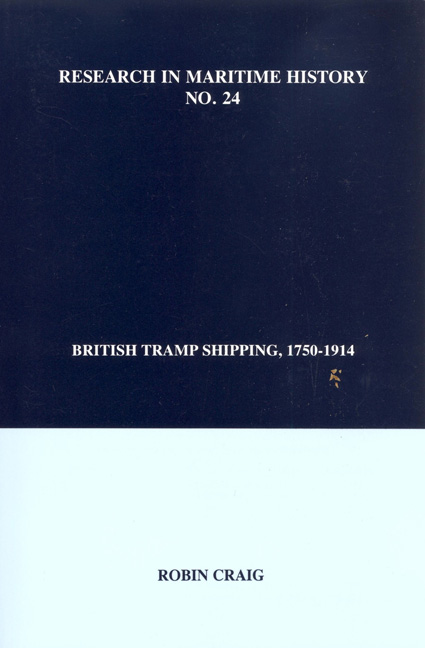Book contents
- Frontmatter
- Contents
- Introduction
- Tramp Shipping and Ownership
- “Aspects of Tramp Shipping and Ownership”
- “Capital Formation in Shipping”
- The Trades
- The Seamen
- Tramp-Shipping Regions
- A. Wales
- B. The Northwest
- C. The West Country
- D. The Northeast
- E. The Southeast
- F. The British Empire: Maritime Canada
- Bibliography
“Aspects of Tramp Shipping and Ownership”
from Tramp Shipping and Ownership
- Frontmatter
- Contents
- Introduction
- Tramp Shipping and Ownership
- “Aspects of Tramp Shipping and Ownership”
- “Capital Formation in Shipping”
- The Trades
- The Seamen
- Tramp-Shipping Regions
- A. Wales
- B. The Northwest
- C. The West Country
- D. The Northeast
- E. The Southeast
- F. The British Empire: Maritime Canada
- Bibliography
Summary
A very substantial proportion of the accumulation of crew agreements and official logs now happily housed at Memorial University relate to the voyages of tramp steamers. This paper seeks to rescue from obscurity what might otherwise be a rather neglected part of the archive, since the tramp steamer cannot match the sentimental appeal of the sailing ship in her heyday, any more than it can compete with the glamour of the ocean liner.
If we may accept that the term “tramp” was associated exclusively by contemporary writers with the iron or steel-hulled screw steamship as she achieved something approaching technological maturity in the 1880's, we may trace the origins of such cargo carriers to the demands of expanding and diversifying trade early in the nineteenth century. Three trades exemplify the growing impetus towards the adopting and perfection of the bulk carrying steamship and we shall briefly examine them in turn. Each kind of freight - ore, cattle, and coal - made distinctive contributions to the evolution of the merchant marine, an each trade nurtured its visionary figure who believed he perceived the potentialities of a new kind of ship. Each trade manifested also its due proportion of those who miscalculated or saw their hopes deferred or destroyed. If we pay some attention to the failures it is no more than the study of maritime history as a discipline should compel. Few industries were more subject to rapid and disconcerting change, and most kinds of history (particularly economic) could benefit from a less single-minded concentration on success as if it were some kind of norm. We ought perhaps to recognize the successful as the deviants in any society.
As early as 1824, Richard Cort, (son of that Henry Cort of Gosport who had been justly celebrated, although inadequately rewarded, for his invention of the puddling process in the manufacture of iron), himself interested in copper as well as iron smelting,6 addressed a report to John Taylor, the eminent mining entrepreneur. This published report7 related to the potentialities of a copper works and colliery estate located on the River Burry, near Swansea in Wales. Cort asserted: “The merits of steam navigation are now so well known that little need be said to induce its adoption, wherever the trade presents a sufficient capability to bear the expense of its application.”
- Type
- Chapter
- Information
- British Tramp Shipping, 1750–1914 , pp. 15 - 40Publisher: Liverpool University PressPrint publication year: 2003

